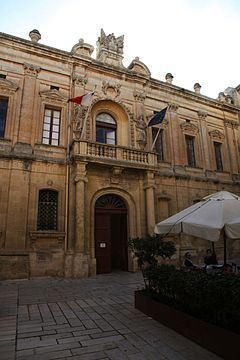Status Intact Construction started 1726 Opened 1728 Architectural style Baroque architecture | Type Courthouse Completed 1728 Floors 2 | |
 | ||
Similar Banca Giuratale, Palazzo Vilhena, Torre dello Standardo, Greeks Gate, Mdina Gate | ||
The Corte Capitanale is a former courthouse in Mdina, Malta, which currently serves as a city hall. It was built in the Baroque style between 1726 and 1728, to designs of the French architect Charles François de Mondion. The building is linked to Palazzo Vilhena, but it has its own entrance and façade.
Contents
History
The Corte Capitanale was built between 1726 and 1728 along with the rest of Palazzo Vilhena, the Grand Master's official residence in Mdina. The building was mainly a courthouse, but it also served as the seat of the Capitano della Verga. Its linking to the palace was a symbolic gesture to convey the fact that the courts were under the jurisdiction of the Order of St. John. The courthouse was also linked to the Bishop's Palace through a now-blocked underground passage, indicating the Church's role in the courts. The building remained a courthouse until 1818.
Today, the Corte Capitanale is Mdina's city hall, being the seat of the city's local council. The council considers the building as inadequate, and in 2012 it requested to move its premises to the Banca Giuratale. It is not regularly open to the public, but the main hall is occasionally open with temporary historical or cultural exhibitions.
The building was included on the Antiquities List of 1925. It is now a Grade 1 national monument and it is listed on the National Inventory of the Cultural Property of the Maltese Islands.
Architecture
The Corte Capitanale is built in the French Baroque style. The façade is decorated by superimposed Tuscan and Corinthian pilasters, and a cornice along roof level. A balcony is located above the main doorway, and it is decorated with allegorical statues of Justice and Mercy. The inscription Legibus et Armis (by using laws and arms) is inscribed below the centrepiece of the façade.
The courthouse incorporates some prison cells and dungeons, which had been built in the 16th century. The building is also linked to a loggia known as Herald's Loggia, from which town criers used to announce decrees to the people. The loggia also predates the courthouse, and it is believed to date to the 17th century.
